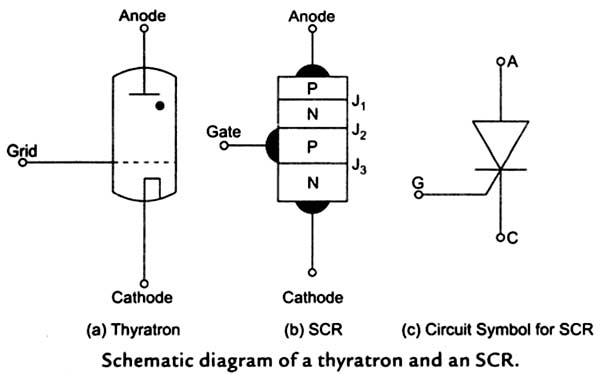A thyristor equivalent of a thyratron tube is a
Right Answer is:
Silicon controlled rectifier
SOLUTION
History of Power amplifier
Power electronics originated at the beginning of the 19th century with the development of mercury-arc rectifiers. A mercury-arc rectifier or mercury-vapor valve is a type of electrical rectifier which is used to convert high ac voltage into dc voltage. They were very useful to provide power for industrial motors, electric railways, and electric locomotives, as well as high voltage direct current (HVDC) power transmission. The mercury arc rectifiers with a glass envelope, grid controlled mercury-arc rectifiers and mercury-arc rectifiers with metal envelope were developed in 1900, 1903 and 1908 respectively. Thyratrons, i.e., hot cathode mercury arc rectifier with grid control was developed by Langmuir in 1914.
The thyratron is a type of gas-filled tube that is used as a high voltage electrical switch and a controlled rectifier. Usually, thyratrons are manufactured as triode, tetrode, and pentode. Due to the mercury vapor or neon or xenon gas fill, thyratrons can handle much greater currents.
In 1925, the first solid-state power device, a selenium rectifier was developed without a glass tube. The selenium rectifier is also known as the metal rectifier. The selenium rectifier is an early type of semiconductor rectifier in which the semiconductor is a copper oxide or selenium. This device is used in phase-controlled converters, inverters, battery chargers, and cyclo-converters.
In 1930, cyclo-converters, i.e., a variable frequency output voltage from the fixed frequency input voltage, were developed by Rissik. In 1933, Lenz developed the ac voltage regulator or controller using solid-state power devices. In 1947, the point-contact transistor was developed by W. H. Brattain, J. Bardeen, and W. Shockley.
The bipolar junction transistor (BJT) using germanium was invented in 1948 and this was the beginning of the new age of semiconductor electronics. There has been much reduced in size, cost, and power consumption of solid-state power devices, and simultaneously the research is going on to develop equipment with more complexity and more power handling capability.
A 100A germanium power diode was developed in 1953. A new revolution began in 1956 with the development of thyristor, i.e., a four-layer silicon PNPN device. The most popular semiconductor device of the thyristor family is the SCR which was introduced by General Electric in 1957.
The thyratron is a gas-filled vacuum tube that acts as an on-off switch. Similar in action to a silicon-controlled rectifier, once fired by a small signal, it continues to conduct until the current flow is interrupted.

Silicon Controlled Rectifier: a solid-state, controlled rectifier usually used as an electronic switch, like a super-quick relay. A small current “fires” or triggers the device, causing it to conduct freely. It is similar to a thyratron tube.
